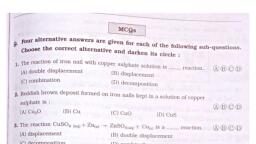Question 1 :
Write the balanced chemical equation for the following and identify the type of reaction in each case:
Hydrogen (g) + Chlorine (g) $\rightarrow$ Hydrogen chloride (g)
Question 2 :
Balance the following chemical equations:
$NaOH + H_{2}SO_{4} \rightarrow Na_{2}SO_{4} + H_{2}O$
Question 3 :
Write the balanced chemical equation for the following and identify the type of reaction in each case:
Zinc carbonate (s) $\rightarrow$ Zinc oxide (s)+ Carbon dioxide (g)
Question 4 :
Which of the statements about the reaction below are incorrect?
2PbO(s) + C(s) $\rightarrow$ 2Pb(s) + $CO_{2}(g)$
(i) Lead is getting reduced
(ii) Carbon dioxide is getting oxidised
(iii) Carbon is getting oxidised
(iv) Lead oxide is getting reduced
Question 5 :
What happens when dilute hydrochloric acid is added to iron filings?
Question 6 :
Identify the substances that are oxidised in the following reactions.
$4Na(s) + O_{2}(g) \rightarrow 2Na_{2}O(s)$
Question 7 :
Identify the substances that are reduced in the following reactions.
$CuO(s)+ H_{2}(g) \rightarrow Cu(s)+ H_{2}O(l)$
Question 8 :
Oil and fat containing food items are flushed with nitrogen. Why?
Question 9 :
A solution of a substance 'X' is used for white washing
Name the substance 'X'.
Question 10 :
Write the balanced chemical equations for the following reactions:
Aluminium + Copper chloride $\rightarrow$ Aluminium chloride + Copper
Question 11 :
Translate the following statements into chemical equations and then balance them:
Potassium metal reacts with water to give potassium hydroxide and hydrogen gas.
Question 12 :
Balance the following chemical equations:
$NaCl + AgNO_{3} \rightarrow AgCl + NaNO_{3}$
Question 13 :
Translate the following statements into chemical equations and then balance them:
Hydrogen gas combines with nitrogen to form ammonia.
Question 14 :
Translate the following statements into chemical equations and then balance them:
Hydrogen sulphide gas burns in air to give water and sulphur dioxide.
Question 15 :
Identify the substances that are reduced in the following reactions.
$CuO(s)+ H_{2}(g) \rightarrow Cu(s)+ H_{2}O(l)$
Question 16 :
Translate the following statements into chemical equations and then balance them:
Hydrogen sulphide gas burns in air to give water and sulphur dioxide.
Question 17 :
Identify the substances that are reduced in the following reactions.
$4Na(s) + O_{2}(g) \rightarrow 2Na_{2}O(s)$
Question 19 :
Balance the following chemical equations:
$NaOH + H_{2}SO_{4} \rightarrow Na_{2}SO_{4} + H_{2}O$
Question 20 :
A solution of a substance 'X' is used for white washing
Write the formula of 'X'.
Question 21 :
Identify the substances that are oxidised in the following reactions.
$4Na(s) + O_{2}(g) \rightarrow 2Na_{2}O(s)$
Question 22 :
Write the balanced chemical equation for the following and identify the type of reaction in each case:
Magnesium (s)+ Hydrochloric acid (aq) $\rightarrow$ Magnesium chloride (aq) + Hydrogen (g)
Question 24 :
Balance the following chemical equations:
$BaCl_{2} + H_{2}SO_{4} \rightarrow BaSO_{4} + HCl$
Question 25 :
Oil and fat containing food items are flushed with nitrogen. Why?
Question 26 :
Write the balanced chemical equations for the following reactions:
Barium chloride + Potassium sulphate $\rightarrow$ Barium sulphate + Potassium chloride
Question 27 :
Balance the following chemical equations:
$HNO_{3} + Ca(OH)_{2} \rightarrow Ca(NO_{3})_{2} + H_{2}O$
Question 28 :
Translate the following statements into chemical equations and then balance them:
Hydrogen gas combines with nitrogen to form ammonia.
Question 30 :
What happens when dilute hydrochloric acid is added to iron filings?
Question 31 :
The following reaction is an example of :
$Fe_{2}O_{3} + 2Al \rightarrow Al_{2}O_{3} + 2Fe$
Question 32 :
The following reaction is an example of :
$Fe_{2}O_{3} + 2Al \rightarrow Al_{2}O_{3} + 2Fe$
Question 33 :
Write the balanced chemical equations for the following reactions:
Aluminium + Copper chloride $\rightarrow$ Aluminium chloride + Copper
Question 34 :
Give an example of a double displacement reaction other than the reaction of barium chloride with sodium sulphate.
Question 35 :
Identify the substances that are oxidised in the following reactions.
$CuO(s)+ H_{2}(g) \rightarrow Cu(s)+ H_{2}O(l)$
Question 36 :
Write the balanced chemical equations for the following reactions:
Calcium hydroxide + Carbon dioxide $\rightarrow$ Calcium carbonate + Water
Question 37 :
Give an example of a double displacement reaction other than the reaction of barium chloride with sodium sulphate.
Question 38 :
Translate the following statements into chemical equations and then balance them:
Potassium metal reacts with water to give potassium hydroxide and hydrogen gas.
Question 39 :
Why does the colour of copper sulphate solution change when an iron nail is dipped in it?
Question 41 :
Write the balanced chemical equations for the following reactions:
Calcium hydroxide + Carbon dioxide $\rightarrow$ Calcium carbonate + Water
Question 42 :
Write the balanced chemical equations for the following reactions:
Barium chloride + Potassium sulphate $\rightarrow$ Barium sulphate + Potassium chloride
Question 43 :
Balance the following chemical equations:
$HNO_{3} + Ca(OH)_{2} \rightarrow Ca(NO_{3})_{2} + H_{2}O$
Question 44 :
Write the balanced chemical equations for the following reactions:
Zinc+ Silver nitrate $\rightarrow$ Zinc nitrate + Silver
Question 45 :
Translate the following statements into chemical equations and then balance them:
Barium chloride reacts with aluminium sulphate to give aluminium chloride and a precipitate of barium sulphate.
Question 46 :
Write the balanced chemical equations for the following reactions:
Zinc+ Silver nitrate $\rightarrow$ Zinc nitrate + Silver
Question 47 :
Write the balanced chemical equation for the following and identify the type of reaction in each case:
Hydrogen (g) + Chlorine (g) $\rightarrow$ Hydrogen chloride (g)
Question 48 :
Balance the following chemical equations:
$BaCl_{2} + H_{2}SO_{4} \rightarrow BaSO_{4} + HCl$
Question 49 :
Which of the statements about the reaction below are incorrect?
2PbO(s) + C(s) $\rightarrow$ 2Pb(s) + $CO_{2}(g)$
(i) Lead is getting reduced
(ii) Carbon dioxide is getting oxidised
(iii) Carbon is getting oxidised
(iv) Lead oxide is getting reduced
Question 50 :
A shiny brown coloured element X on heating in air becomes black in colour. Name the element X and the black coloured compound formed.













































